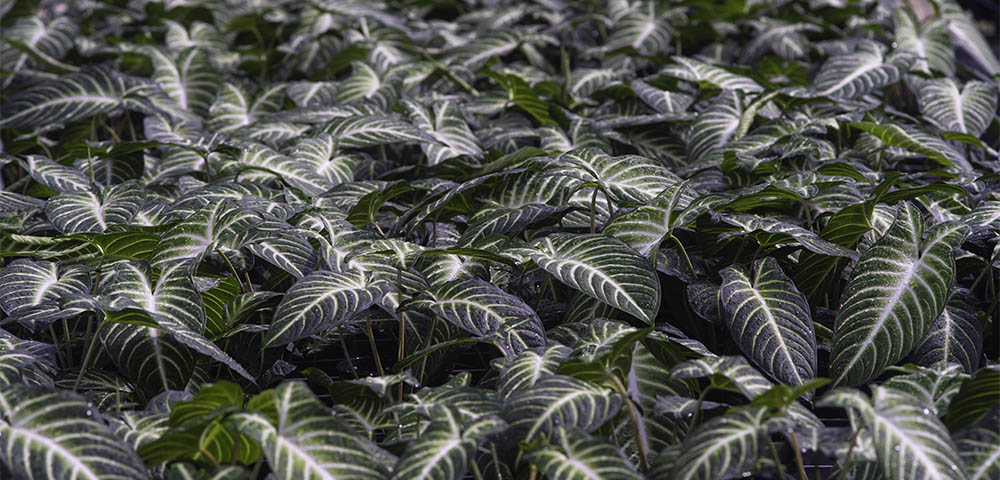Xanthosoma (Phyllotaenium lindenii)
Xanthosoma Plant Features
One of the more visually striking houseplants you can grow, xanthosoma (Caladium lindenii) is a rare tropical plant from Colombia. It features large, arrow-shaped green leaves dramatically highlighted with eye-catching creamy-white veins. It's sure to stand out from your other indoor plants, even variegated varieties.
As it matures, xanthosoma grows 2 to 3 feet tall, making it a remarkable floor plant for warm, bright spots. Mature leaves can be more than 15 inches long! When younger, it's an ideal specimen for bright desks and tabletops.
Highlight it in your collection by growing it with dark-leaf houseplants like Raven® ZZ or fiddle leaf fig. Or go crazy and pair it with other striped houseplants, such as zebra plant or nerve plant.
Note: You might see this plant sold under a variety of names as botanists have reclassified it several times. Caladium lindenii, Xanthosoma lindenii, and Phyllotaenium lindenii are different names the same variety.
Buy it online and have it shipped fresh from our farm, direct to your door from our online plant shop. Look for Costa Farms' xanthosoma in the Trending Tropicals® collection at your favorite retailer. See a list of our in-store and online retailer partners.
Xanthosoma Growing Instructions
Light
Indoors, xanthosoma likes a spot with medium to bright, indirect light. It thrives under both natural light and artificial light (such as fluorescent or LED bulbs). Avoid direct afternoon sun, especially in hot-summer climates. Too much direct sun, even through a window, can cause sunburned patches of the foliage.
Tip: If you have a sunny window but it's too much direct sun, filter the light through a sheer curtain.
Outdoors, xanthosoma can be grown in a shaded spot.
Water
Water xanthosoma as the top couple of inches of the potting mix dry to the touch. How much water this is and how often it needs to be applied differs from situation to situation. Factors such as light, temperature, and pot size all impact a plant's water usage.
Take care not to overwater your xanthosoma. If it stays wet for extended periods, especially in short winter days, the roots will suffocate, die, and rot. When well watered, the foliage tends to stand upright. As it gets thirsty, the leaves tend to take on a droopy appearance.
Humidity
Xanthosoma prefers above-average relative humidity levels when grown indoors. If the air is too dry, you may see the leaf tips and edges get brown and crispy.
In areas with dry indoor air, you can provide more humidity by growing it in a large terrarium, grouping other houseplants around your xanthosoma, placing a small humidifier nearby, or growing it over a large pebble tray.
Tip: Misting isn't all that helpful for raising humidity as it provides only a short-term boost.
Pruning
Clip off old, faded xanthosoma leaves as they age. No other pruning is required.
Fertilizer
Push more growth from your xanthosoma by fertilizing in spring and summer. Use a general-purpose fertilizer labeled for houseplants. Different fertilizers have different application rates and frequencies, so follow the directions on the product packaging.
Tip: Never apply more fertilizer than the packaging instructions recommend. Too much fertilizer can burn plant roots, causing leaves to die.
Xanthosoma is grown for ornamental use only and is not intended for human or animal consumption. We advise keeping it out of reach of children or pets that may ingest it.
-
Water
Medium water needs
-
Light
Indoors: High light
Indoors: Medium light
-
Colors
Variegated
-
Special Features
Purifies the air
Complement your Xanthosoma
Moonlight ScindapsusSterling Silver scindapsus is another relative of xanthosoma. Its silver-flushed leaves are a beautiful accent.
Birkin Philodendron
If you love stipes, pair xanthosoma with its relative, Birkin philodendron. The two combine dramatically.
Geo
Go bold! Mix the dark green, otherworldly leaves of Geo (Geogenanthus ciliatus) with Xanthosoma's bold variegation.
Q&A
My Xanthosoma has brown stuff on the stems? Is it normal? Does it have a pest or disease?Good news! Xanthosoma petioles (or leaf stems) have reddish-brown hairs on them. This is perfectly natural and how the plant grows. It's nothing to worry about and how the plant grows.

